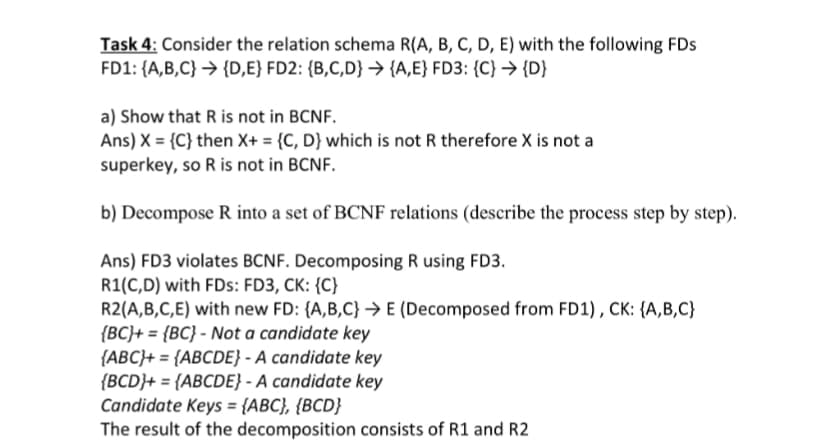Task 4: Consider the relation schema R(A, B, C, D, E) with the following FDs FD1: {A,B,C} → {D,E} FD2: {B,C,D} → {A,E} FD3: {C} → {D} a) Show that R is not in BCNF. Ans) X = {C} then X+ = {C, D} which is not R therefore X is not a superkey, so R is not in BCNF. b) Decompose R into a set of BCNF relations (describe the process step by step). Ans) FD3 violates BCNF. Decomposing R using FD3. R1(C,D) with FDs: FD3, CK: {C} R2(A,B,C,E) with new FD: {A,B,C} → E (Decomposed from FD1), CK: {A,B,C} {BC}+ = {BC} - Not a candidate key {ABC}+ = {ABCDE} - A candidate key {BCD}+ = {ABCDE} - A candidate key Candidate Keys = {ABC}, {BCD} The result of the decomposition consists of R1 and R2 %3D %3D %3D
Task 4: Consider the relation schema R(A, B, C, D, E) with the following FDs FD1: {A,B,C} → {D,E} FD2: {B,C,D} → {A,E} FD3: {C} → {D} a) Show that R is not in BCNF. Ans) X = {C} then X+ = {C, D} which is not R therefore X is not a superkey, so R is not in BCNF. b) Decompose R into a set of BCNF relations (describe the process step by step). Ans) FD3 violates BCNF. Decomposing R using FD3. R1(C,D) with FDs: FD3, CK: {C} R2(A,B,C,E) with new FD: {A,B,C} → E (Decomposed from FD1), CK: {A,B,C} {BC}+ = {BC} - Not a candidate key {ABC}+ = {ABCDE} - A candidate key {BCD}+ = {ABCDE} - A candidate key Candidate Keys = {ABC}, {BCD} The result of the decomposition consists of R1 and R2 %3D %3D %3D
Database System Concepts
7th Edition
ISBN:9780078022159
Author:Abraham Silberschatz Professor, Henry F. Korth, S. Sudarshan
Publisher:Abraham Silberschatz Professor, Henry F. Korth, S. Sudarshan
Chapter1: Introduction
Section: Chapter Questions
Problem 1PE
Related questions
Question

Transcribed Image Text:Task 4: Consider the relation schema R(A, B, C, D, E) with the following FDs
FD1: {A,B,C} → {D,E} FD2: {B,C,D} → {A,E} FD3: {C} → {D}
a) Show that R is not in BCNF.
Ans) X = {C} then X+ = {C, D} which is not R therefore X is not a
superkey, so R is not in BCNF.
b) Decompose R into a set of BCNF relations (describe the process step by step).
Ans) FD3 violates BCNF. Decomposing R using FD3.
R1(C,D) with FDs: FD3, CK: {C}
R2(A,B,C,E) with new FD: {A,B,C}→ E (Decomposed from FD1), CK: {A,B,C}
{BC}+ = {BC} - Not a candidate key
{ABC}+ = {ABCDE} - A candidate key
{BCD}+ = {ABCDE} - A candidate key
Candidate Keys = {ABC}, {BCD}
The result of the decomposition consists of R1 and R2
%3D
%3D
Expert Solution
This question has been solved!
Explore an expertly crafted, step-by-step solution for a thorough understanding of key concepts.
This is a popular solution!
Trending now
This is a popular solution!
Step by step
Solved in 2 steps

Knowledge Booster
Learn more about
Need a deep-dive on the concept behind this application? Look no further. Learn more about this topic, computer-science and related others by exploring similar questions and additional content below.Recommended textbooks for you

Database System Concepts
Computer Science
ISBN:
9780078022159
Author:
Abraham Silberschatz Professor, Henry F. Korth, S. Sudarshan
Publisher:
McGraw-Hill Education

Starting Out with Python (4th Edition)
Computer Science
ISBN:
9780134444321
Author:
Tony Gaddis
Publisher:
PEARSON

Digital Fundamentals (11th Edition)
Computer Science
ISBN:
9780132737968
Author:
Thomas L. Floyd
Publisher:
PEARSON

Database System Concepts
Computer Science
ISBN:
9780078022159
Author:
Abraham Silberschatz Professor, Henry F. Korth, S. Sudarshan
Publisher:
McGraw-Hill Education

Starting Out with Python (4th Edition)
Computer Science
ISBN:
9780134444321
Author:
Tony Gaddis
Publisher:
PEARSON

Digital Fundamentals (11th Edition)
Computer Science
ISBN:
9780132737968
Author:
Thomas L. Floyd
Publisher:
PEARSON

C How to Program (8th Edition)
Computer Science
ISBN:
9780133976892
Author:
Paul J. Deitel, Harvey Deitel
Publisher:
PEARSON

Database Systems: Design, Implementation, & Manag…
Computer Science
ISBN:
9781337627900
Author:
Carlos Coronel, Steven Morris
Publisher:
Cengage Learning

Programmable Logic Controllers
Computer Science
ISBN:
9780073373843
Author:
Frank D. Petruzella
Publisher:
McGraw-Hill Education